DESERTS
Desert: a region with so little vegetation that no significant
population
can be supported on that land. This implies that it is dry, but
not
necessarily hot.
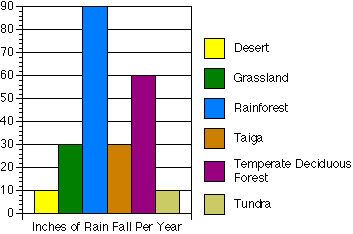
There are several kinds of deserts, but they all have one thing in
common
- they each receive less than 25 cm (~10") of precipitation per year.
-
Polar ice and snow deserts - the cold climate produces both low
precipitation
and relatively high evaporation rates, e.g., Antarctica.
-
Middle latitude deserts in the interiors of continents - characterized
by low rainfall and high summer temperatures, e.g., Gobi Desert of
Mongolia.
-
Trade wind deserts - roughly centered at latitudes of 30°N and 30
°S;
high level winds descend from the equator and from higher latitudes,
i.e.,
they are located at boundaries between Hadley circulation cells, e.g.,
Sahara and Simpson deserts. As the air masses descend, they heat
up and their ability to hold moisture increases - therefore areas below
these descending air masses tend to loose moisture rather than gain
moisture.
-
Coastal deserts where cold oceans lie next to hot coastal regions -
most
of the precipitation falls over the oceans before it gets to the land,
e.g., Atacama and Kalahari deserts.
-
Orographic deserts - deserts that receive little moisture due to the
"rain
shadow" effect of nearby mountains, e.g., Basin and Range of Nevada and
eastern Oregon's deserts.
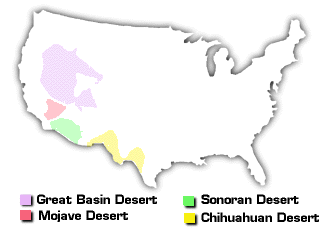
Desert Processes
Aeolian processes - caused by the wind (remember, the wind is
a low density, low viscosity fluid)
-
abrasion - a physical weathering process.
-
ventifacts - stones that have been sculpted by the wind.
-
desert varnish - the patina of iron and maganese oxides left
on
rocks after they have undergone long periods of chemical weathering in
the desert.
-
desert pavement: forms when wind removes all of the
fine-grained
sand from a system, leaving only the coarse gravel behind. Below
are three examples of a desert pavements, or regs. The
first
is a region that is actively undergoing deflation (a process in which
the
finer material is removed). The second photo shows the process
continuing,
whereas the third photo is a desert pavement, or reg.
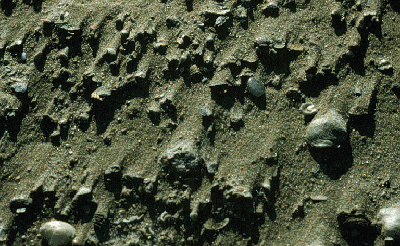
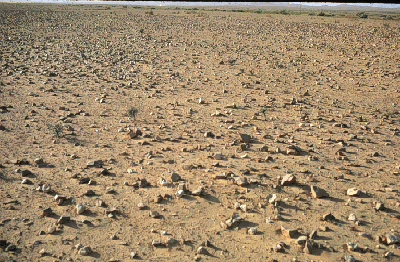
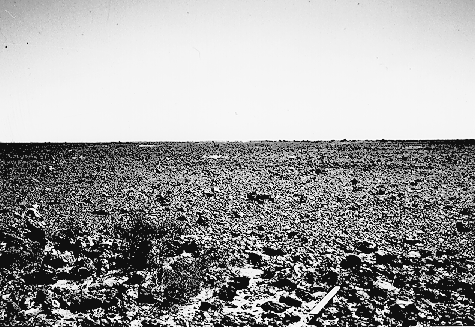
Depositional features - sand dunes
In a desert, material moves primarily by the wind through a process
called saltation. This is the same type of jumping processes in
which
some material is carried as bedload in a stream. However, like in
a stream, the most erosive agent is water. Even though rainfall
is
scarce, it usually comes in a few sudden, intense thunderstorm
events.
The water is not able to soak into the ground in such a short amount of
time, so it flows across the ground as sheetflow, coalescing into
gullies
and rivers that can erode arroyos into the landscape very
quickly.
An arroyo is a term for a gully in an arid environment that has almost
vertical sides and a flat channel floor.
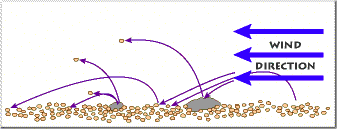
Saltation may not move the larger particles; they may be left and
form
a desert pavement. Any vegetation, or other item, may
also
block the wind. That would allow small dunes to begin to form in
the object's windshadow. In the images below, the wind is blowing
from left to right and a windshadow is being created downwind of the
object
- allowing the finer material to accumulate.
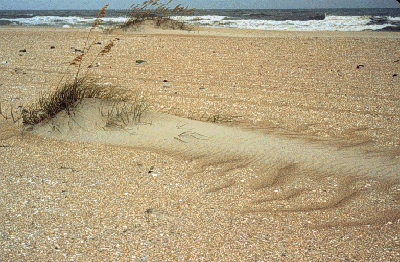
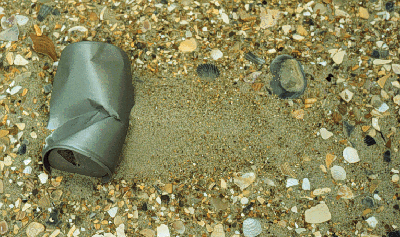
There are many different types of sand dunes found in the
desert.
Below are some drawings from the US Geological Survey that show some of
the major types of sand dunes. and how they relate to the various wind
directions.
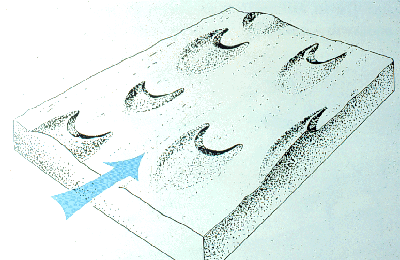
barchan
dune: crescent shaped dune with "horns" pointing downwind
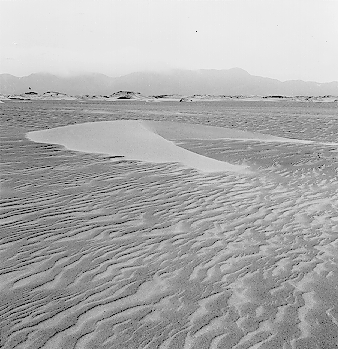
Above is an isolated barchan dune that has some small transverse dunes
nearby.
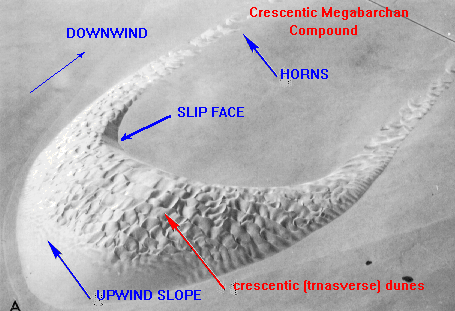
Above is a barchan dune that has various features labeled. (Yes,
I know transverse is spelled wrong)
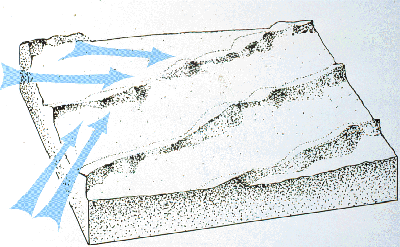
longitudinal dune: linear dune that moves ~parallel to the wind
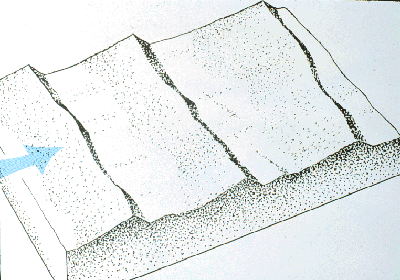
transverse dune: linear dune that moves ~perpendicular to the wind

star dune: dune that forms when there are a number of dominant
wind directions
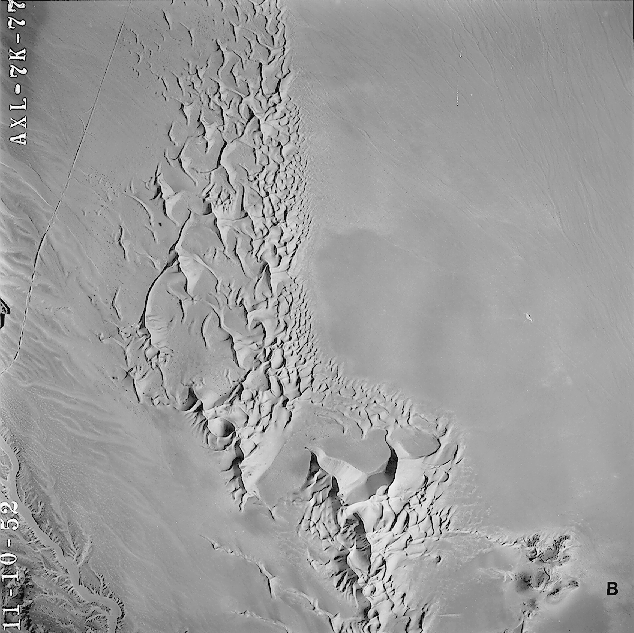
The airphoto above is a good example of star dunes
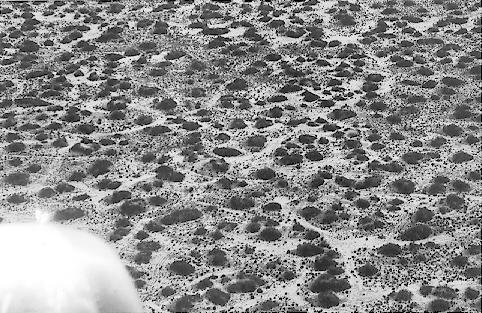
coppice dune: a small dune that has been stabilized by vegetation
Parabolic dunes are similarly shaped as barchan dunes
(crescent
shaped) except that in this case, the wind is blowing so that the
"horns"
are pointing upwind since they have been stabilized.
When the winds are primarily from one direction, but occasionally
reverse
directions a feature known as a Chinese Wall can develop on the crest
of
dunes. The photograph below shows a good example of Chinese Walls
on dunes in a dune field. If the dune field is very large, it is
called a sand sea or erg.
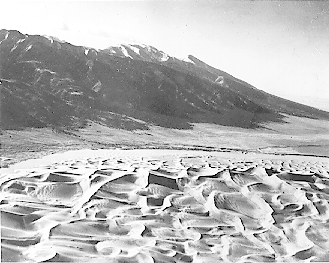
If the wind erodes all of the fine material from an area it may
start
to erode into the local bedrock. This is called a blowout.
If the erosion continues streamlined bedrock hills may form - they are
called yardangs (see the airphoto below)
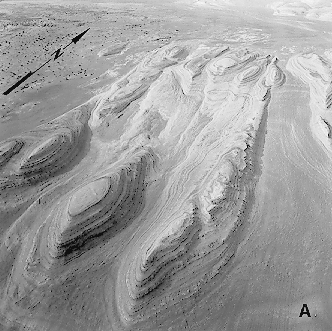
Processes associated with water (a relatively high density,
high
viscosity fluid)
Ephemeral streams in steep sided valleys (arroyos and canyons) are
very
common in arid and semiarid environments.

-
In general, V-shaped gullies (type A) with short, steep gradients are
indicative
of granular and semigranular, nonplastic, noncohesive soils, i.e.,
sand,
gravel, and combinations of the two. As silt and clay particles are
added,
the V-shape broadens and becomes rounded, the gradient shallows, and
the
slope lengthens. Alluvial fans are common at mouths of A-type gullies.
-
V-shaped gullies with steep sides and flat bottoms (type B) have long
slopes
and gentle gradients ending in steep faces. This type of cross section
is characteristic of many loess deposits. Alluvial fans are not formed
at the mouths of these gullies.
-
Box-shaped gullies (type C) with vertical sides, and flat bottoms with
long, gentle gradients are characteristic of water-deposited silt and
marine
sand and clay, as on the eastern U.S. coastal plain. This shape is also
characteristic of subsurface drainage or ground water sapping, and it
is
found in granular and silty soils resting on a nonpermeable or
semipermeable
layer.
-
Saucer-shaped gullies (type D) with gentle side slopes and broad,
rounded
cross sections are characteristic of nongranular, cohesive, plastic
soils,
i.e., clay and silty clay. Gradients of these gullies are very
gentle,
and the gully extends for great distances, gradually feathering out to
become indistinguishable from the surrounding terrain.
Alluvial fans - debris that accumulates at the foot of a
mountain
range in an arid environment. As a stream's gradient is abruptly
decreased, the bedload and suspended load drops out. In the
airphoto
below, the number "1" points out the edge of a single alluvial fan that
has been cut by an arroyo.
Bajadas - coalescing alluvial fans. In the airphoto
below,
the bajada is the region between the dashed blue lines.
Playas - ephemeral lake; in the airphoto below, the a playa
can
be seen as the bright patch southwest of the number "2".
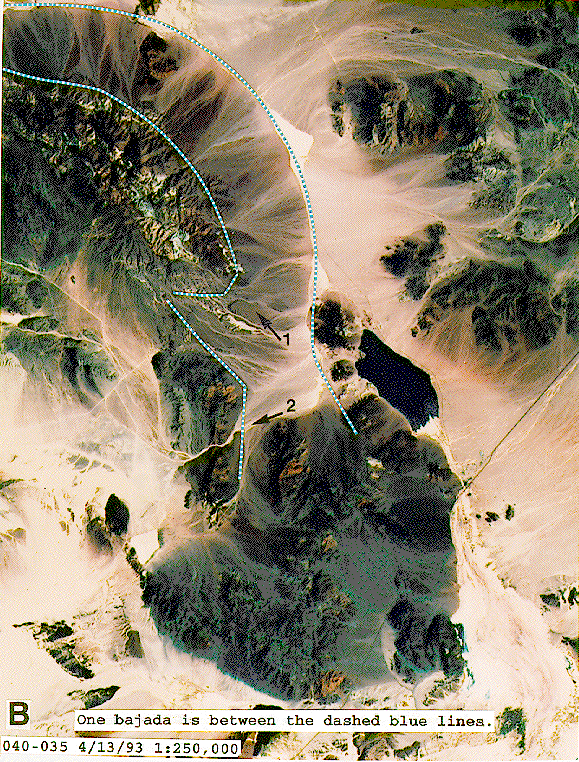
In the photo above, another feature that is common in some deserts
can be seen. Immediately to the east (right) of the number "1" is
an inselberg - the top of a peak in which the rest of the mountain has
been covered by sediment. As you can imagine, this process has
taken
millions of years to happen.
Terms for desert surfaces
-
hamada: bare rock or rock with a thin veneer of pebble (Arabic?)
-
gobi: rock floored desert plain (Mongol)
-
gibber plain: stony (often ventifacts) desert (Australian)
-
reg: desert pavement of loose stones (N. Africa)
-
serir: desert pavement of loose stones, coarser and older than reg (N.
Africa)
-
debba: extensive sandy plain (N. Africa)
-
dune field: extensive group of dunes
-
erg: vast region deeply covered with sand and topped by sand dunes (N.
Africa)
-
playa, pan: extremely flat, vegetation free area of silt or clay in the
lowest part of a closed basin (N. America, SW. Africa)
-
salina: playa with saline water or kept moist by rising groundwater (N.
& S. America, Spain)
-
chott: closed basin containing a dry lake or playa (N. African)
-
sabkha, sebka: temporary lake or playa; marsh, salt flat or salt lake
(N.
African)
-
salar, salina: desert floor basin with salt deposit (Chile & Peru)
-
balat: desert marsh, depression or mudflat (N. African)
-
mbuga: temporary swamp or black clay pan (SW. Africa)




















